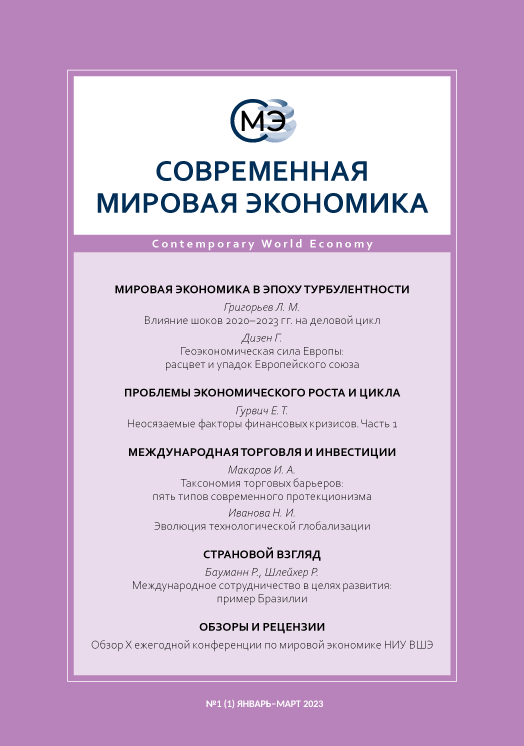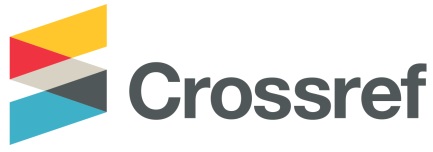Таксономия торговых барьеров: пять типов протекционизма
Аннотация
Данная статья рассматривает различные мотивы введения торговых барьеров, выделяя на этой основе пять типов протекционизма. Если в XX веке доминировали «протекционизм лоббистов» и «протекционизм индустриализаторов», то период после финансово-экономического кризиса 2008–2009 годов стал временем расцвета «протекционизма геостратегов» и «протекционизма популистов». Наконец, введение пограничного компенсационного углеродного механизма в ЕС может стать началом распространения «беневолентного протекционизма». Предложенная таксономия протекционизма демонстрирует, почему, несмотря на консенсус экономистов о пользе международной торговли, протекционизм по-прежнему так распространен. Она также позволяет объяснить, почему основная роль в интенсивном росте торговых барьеров в 2010–2020-е годы принадлежит развитым странам, ранее выступавшим главными сторонниками свободной торговли и глобализации.
Скачивания
Литература
Amiti, M., Redding, S. and Weinstein, D., 2019. The Impact of the 2018 Trade War on Prices and Welfare. Journal of Economic Perspectives, 33 (4), pp.187-210.
Bairoch, P., 1995. Economics and World History: Myths and Paradoxes. Chicago: University of Chicago Press.
Baldwin, R.E., 2016. The Great Convergence: Information Technology and the New Globalization. Cambridge: Harvard University Press.
Beghin, J.C. and Elobeid, A., 2017. Analysis of the US Sugar Program. [pdf] Available at: <https://www.aei.org/wp-content/uploads/2017/11/Analysis-of-the-US-Sugar-Program.pdf> [Accessed 24 April 2023].
Blanchard, E.J., Bown, C.P. and Chor, D., 2019. Did Trump’s trade war impact the 2018 election? [pdf] Available at: <https://www.nber.org/system/files/working_papers/w26434/w26434.pdf> [Accessed 24 April 2023].
Borchert, I., Gootiiz, B., Grover, A., Matoo, A., 2012. Landlocked or Policy Locked? How Services Trade Protection Deepens Economic Isolation. [pdf] Available at: <https://ferdi.fr/dl/df-HQS8qbA1eJDXLQb6BE38YyYY/document-landlocked-or-policy-locked-how-services-trade-protection-deepens.pdf> [Accessed 24 April 2023].
Brander, J.A., 1986. Rationales for Strategic Trade and Industrial Policy. In: P. Krugman, ed. 1986. Strategic Trade Policy and the New International Economics. Cambridge: MIT Pres.
Clark Center Forum, 2012. Free Trade. [online] Available at: <https://www.igmchicago.org/surveys/free-trade/> [Accessed 24 April 2023].
Cox, L., 2021. The long-term impact of steel tariffs on US manufacturing. [pdf] Available at: <https://economics.princeton.edu/wp-content/uploads/2022/06/cox_steel_20220601.pdf> [Accessed 24 April 2023].
Davies, R.B. and Vadlamannati, K.C., 2013. A race to the bottom in labor standards? An empirical investigation. Journal of Development Economics, 103, pp.1-14.
Di Tella, R. and Rodrik, D., 2020. Labour market shocks and the demand for trade protection: Evidence from online surveys. The Economic Journal, 130 (628), pp.1008-1030.
Dixit, A.K. and Stiglitz, J.E., 1977. Monopolistic Competition and Optimum Product Diversity. American Economic Review, 67 (3), pp. 297-308.
Durán, G.M., 2023. Securing Compatibility of Carbon Border Adjustments with the Multilateral Climate and Trade Regimes. International & Comparative Law Quarterly, 72 (1), pp.73-103.
Ehrlich, S.D., 2008. The Tariff and the Lobbyist: Political Institutions, Interest Group Politics, and US Trade Policy. International Studies Quarterly, 52 (2), pp.427-445.
European Commission, 2022. European Green Deal: Agreement reached on the Carbon Border Adjustment Mechanism (CBAM). [online] Available at: <https://ec.europa.eu/commission/presscorner/detail/en/ip_22_7719> [Accessed 24 April 2023].
Fajgelbaum, P.D., Goldberg, P.K., Kennedy, P.J. and Khandelwal, A.K., 2020. The return to protectionism. The Quarterly Journal of Economics, 135 (1), pp.1-55.
Farrell, H. and Newman, A.L., 2019. Weaponized Interdependence: How Global Economic Networks Shape State Coercion. International Security, 44 (1), pp.42-79.
Feenstra, R.C. and Weinstein, D.E., 2017. Globalization, Markups, and US Welfare. Journal of Political Economy, 125 (4), pp.1040-1074.
G7 Germany, 2022. G7 Leaders’ Communiqué. [pdf] Available at: <https://www.g7germany.de/resource/blob/974430/2062292/9c213e6b4b36ed1bd687e82480040399/2022-07-14-leaders-communique-data.pdf?download=1> [Accessed 24 April 2023].
Global Trade Alert, 2023. Global Dynamics. [online] Available at: <https://www.globaltradealert.org/global_dynamics> [Accessed 24 April 2023].
Grossman, G.M. and Helpman, E., 1994. Endogenous Innovation in the Theory of Growth. Journal of Economic Perspectives, 8 (1), pp.23-44.
Heckscher, E., 1919. The Effect of Foreign Trade on the Distribution of Income. Ekonomisk Tidskrift, 21, pp. 497-512.
Helleiner, G.K., 1992. Trade Policy, Industrialization, and Development: New Perspectives. Oxford: Oxford University Press.
Howse, R., and Regan, D., 2000. The product/process distinction – an illusory basis for disciplining “unilateralism” in trade policy. European Journal of International Law, 11 (2), pp.249-289.
Irwin, D.A., 1996. The US-Japan semiconductor trade conflict. In: A.O. Krueger, ed. 1996. The Political Economy of Trade Protection. Chicago: University of Chicago Press, pp.5-14.
Keller, W., 2004. International Technology Diffusion. Journal of Economic Literature, 42 (3), pp.752-782.
Kim, I.S., Milner, H.V., 2019. Multinational Corporations and their Influence Through Lobbying on Foreign Policy. Multinational Corporations in a Changing Global Economy, pp. 497-536.
Kim, S.E. and Margalit, Y., 2021. Tariffs as electoral weapons: the political geography of the US–China trade war. International organization, 75 (1), pp.1-38.
Krueger, A.O., 1974. The Political Economy of the Rent-seeking Society. American Economic Review, 64 (3), pp. 291-303.
Krugman, P., 1979. Increasing Returns, Monopolistic Competition, and International Trade. Journal of International Economics, 9 (4), pp.469-479.
Lake, J. and Nie, J., 2022. The 2020 US Presidential election and Trump’s wars on trade and health insurance. European Journal of Political Economy, 102338.
Lamb, R.L., 2006. Rent Seeking in US-Mexican Avocado Trade. Cato Journal, 26 (1), pp.159-177.
Lee, J., 1997. The maturation and growth of infant industries: the case of Korea. World Development, 25 (8), pp. 1271-1281.
List, F., 1856. National System of Political Economy. Philadelphia: JB Lippincott & Company.
Makarov, I.A., 2012. Rol’ SSHA v protivodeystvii global’nomu potrebleniyu klimata [The role of the USA in counteracting global climate change]. SSHA i Kanada: ekonomika, politika, kul'tura [USA and Canada: Economy, Politics, Culture], 4, pp.101-117.
Makarov, I.A., 2022. Mezhdunarodnaya torgovlya: ot giperglobalizatsii k zamedleniyu mezhdunarodnogo obmena [International Trade: From Hyperglobalization to Slowing International Exchanges]. In: L.M. Grigoriev, A.A. Kurdin, I.A. Makarov (eds.), Mirovaya ekonomika v period bol'shikh potryaseniy [World Economy in the Period of Great Shocks], Moscow: INFRA-M, pp. 117-146.
McKinsey, 2015. China is betting big on these 10 industries. [online] Available at: <https://web.archive.org/web/20180915122827/http://mckinseychina.com/chinas-new-initiative-to-promote-homegrown-technology/> [Accessed 24 April 2023].
Melitz, M., 2003. The Impact of Trade on Intra-Industry Reallocations and Aggregate Industry Productivity. Econometrica, 71 (6), pp.1695-1725.
Mitra, D., Thomakos, D.D. and Ulubaşoğlu, M.A., 2002. “Protection for Sale” in a Developing Country: Democracy vs. Dictatorship. Review of Economics and Statistics, 84 (3), pp.497-508.
Mobarak, A.M. and Purbasari, D.P., 2006. Corrupt protection for sale to firms: evidence from Indonesia. [pdf] Available at: <http://spinup-000d1a-wp-offload-media.s3.amazonaws.com/faculty/wp-content/uploads/sites/45/2019/06/corrupt-protection-for-sale-to-firms.pdf> [Accessed 24 April 2023].
Nordhaus, W., 2015. Climate clubs: Overcoming free-riding in international climate policy. American Economic Review, 105 (4), pp.1339-1370.
Ohlin, B., 1967. Interregional and International Trade. Cambridge: Harvard University Press.
Petri, P.A. and Plummer, M.G., 2016. The economic effects of the Trans-Pacific Partnership: New estimates. [pdf] Available at: <https://www.aapa-ports.org/files/PDFs/Peterson%20Institute%20TPP%20report.pdf> [Accessed 24 April 2023].
Pikkety, T., 2017. Capital in the Twenty-First Century. Cambridge: Harvard University Press.
Porter, M., 1998. Competitive Advantage of Nations. New York: Free Press.
Reinert, E.S., 2019. How Rich Countries Got Rich and Why Poor Countries Stay Poor. New York: Public Affairs.
Roach, S., 2014. Unbalanced: The Codependency of America and China. New Haven: Yale University Press.
Rodrik, D., 2011. The globalization paradox: Democracy and the future of the world economy. New York: W. W. Norton & Company.
Rodrik, D., 2018. Populism and the Economics of Globalization. Journal of International Business Policy, 1, pp. 12-33.
Saez, E., and Zucman, G., 2019. The triumph of injustice: How the rich dodge taxes and how to make them pay. New York: W. W. Norton & Company.
Satake, M., 2000. Trade conflicts between Japan and the United States over market access; the case of automobiles and automotive parts. [pdf] Available at: <https://crawford.anu.edu.au/pdf/pep/pep-310.pdf> [Accessed 24 April 2023].
Seitz, M., Tarasov, A. and Zakharenko, R., 2015. Trade Costs, Conflicts, and Defense Spending. Journal of International Economics, 95 (2), pp.305-318.
Stolper, W.F. and Samuelson, P.A., 1941. Protection and real wages. The Review of Economic Studies, 9 (1), pp.58-73.
The Wall Street Journal, 2019. Economists’ Statement on Carbon Dividends. [online] Available at: <https://www.wsj.com/articles/economists-statement-on-carbon-dividends-11547682910> [Accessed 24 April 2023].
Timofeev, I. N., 2019. Politika prinyata: odnopolyarnyy ili mnogopolyarnyy mir? [Sanctions policy: unipolar or multipolar world?], Vestnik mezhdunarodnykh organizatsiy [International Organisations Research Journal], 14 (3), pp. 9-26.
Topalova, P., 2010. Factor immobility and regional impacts of trade liberalization: Evidence on poverty from India. American Economic Journal: Applied Economics, 2 (4), pp.1-41.
Tullock, G., 1967. The Welfare Costs of Tariffs, Monopolies, and Theft. Economic Inquiry, 5 (3), pp.224-232.
Volchkova, N.A., Kuznetsova, P.O., 2019. Skol’ko stoyat kontrsanktsii: analiz blagosostoyaniya [How Much Do Counter-Sanctions Cost: Well-Being Analysis], Zhurnal novoy ekonomicheskoy asotsiatsii [Journal of the New Economic Association], Vol. 4, No 3, pp.173-183.
Williams, G.W. and Hanselka, D., 2020. The Economic Benefits of U.S. Avocado Imports from Mexico. [pdf] Available at: <https://mhaia.org/wp-content/uploads/2022/03/Report-National-and-State-Economic-Benefits-of-Avocado-Imports-from-Mexico-2020-Update-Final.pdf> [Accessed 24 April 2023].
World Trade Organization, 2022. Report of the TPRB from the Director-General on Trade-Related Developments. [pdf] Available at: <https://docs.wto.org/dol2fe/Pages/SS/directdoc.aspx?filename=q:/WT/TPR/OVW16.pdf&Open=True> [Accessed 24 April 2023].
Yanbykh, R., Saraikin, V. and Lerman, Z., 2020. Changes in Russia’s agrarian structure: What can we learn from agricultural census? Russian Journal of Economics, 6 (1), pp.26-41.



.jpg)

